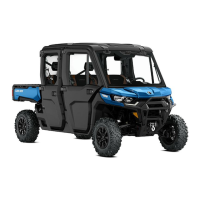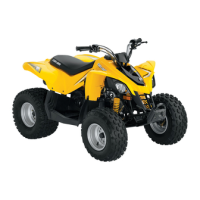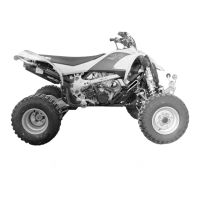MOVING LOADS AND DOING WOR K
Reduce yo ur speed when hauling a
load and turn gradually. Avoid hills and
rough terrain. Nev er attem pt steep
hills. Allow more distance for brak-
ing, especially on inclined surfaces and
when passengers are on board. Be
careful not to skid or slide.
Pullin g a Trailer
NO TICE
A BRP approved rear
hitch plate must be properly in-
stalled on the vehicle for hauling
trailers.
Riding this vehicle w ith a trailer sub-
stantially increases the risk of toppl ing,
especially on i nc line d slopes. If a trailer
is used behind the vehicle ma ke sure
that its hitch is compatible with the
one on the vehicle. Make sure the
trailer is horiz ontal with the ve hicle. (In
some instances a special extension
may have to be installed on the vehicle
hitch). U se security chains or cables to
secure the trailer with the vehicle.
Reduce your speed when pulling a
trailer and turn graduall y. Avoid hills
and rough terrain. Never attempt
steep hills. Allow more distance for
braking, especially on inclined surfa c es
and when passengers are on board.
Be ca reful not to skid or slide.
Improperly loading a trailer may cause
loss of control.
Always make sure load is evenly dis-
tributed an d safely s ecured on the
trailer; an evenly balanced trailer is
easier to control.
Always p ut the shif t lever to L (low
range) for hauling a trailer – in addition
to providing more torque, operating
in low ran ge helps account for the in-
creased load on the rea r tires.
When sto pped or parked, block the ve-
hicle and trailer wheels from possible
movement.
Use caution when disconnecting a
loaded trailer; it or its load may topple
on you or others.
When hauling a trailer, respect the fol-
lowing maximum tongue weight a nd
towing capacity indicated on the label
affi xed to the hitch.
Make sure th ere is at least some
weight on the tongue.
30
_______
SAFETY IN FORM ATION
________

